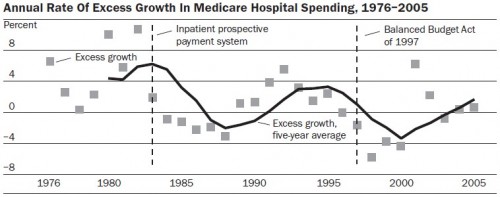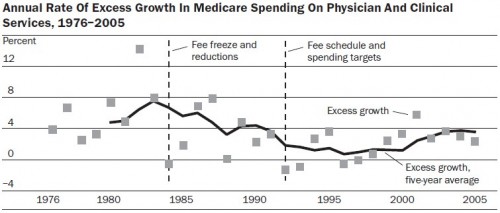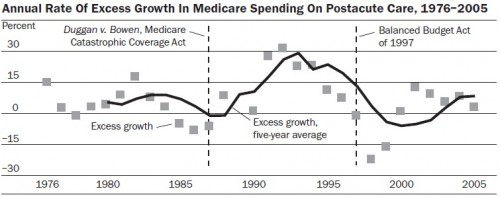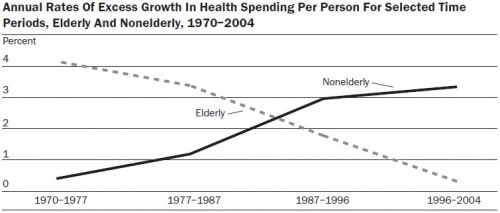This is a TIE-U post associated with Jonathan Oberlander’s Political Dynamics and Policy Dilemmas (UNC’s HPM 757, Fall 2011). For other posts in this series, see the course intro.
Chapin White [1] dissects the slowdown in growth of Medicare spending in a 2008 Health Affairs paper. The abstract and charts tell the story.
So-called excess growth [that above per capita GDP] in Medicare spending per beneficiary has varied widely and has slowed in recent years. The annual rate of excess growth fell from 5.6 percent during 1975–1983, to 2.1 percent during 1983–1997, to only 0.5 percent during 1997–2005. Changes in payment policies and regulations can help explain the observed slowdown. These include new prospective payment systems for hospitals and postacute care providers, and controls on aggregate Medicare physician spending. Competing explanations— increases in managed care enrollment, changes in Medicare cost sharing, and a systemwide spending slowdown—do not account for the slowdown.
Of course the year-by-year data are not as clean as the three averages above might suggest. The following three charts illustrate excess Medicare growth for hospital, physician, and post-acute spending, by year and five-year averages. The key payment policy milestones are drawn as dashed vertical lines. It is these that White credits for the slowdown. This is not mere rhetoric; he does some calculations to show that the other factors mentioned in the abstract cannot explain much, if any, of the slowdown. In particular, “trends in Medicare spending growth can be and have been moderated through means other than increasing beneficiary cost sharing.” More skin in the game may not be necessary.
Perhaps this is not really a Medicare story, though. Maybe Medicare is the beneficiary of a system-wide slowdown. White rejects this hypothesis, illustrating that excess growth in health spending for the nonelderly has increased while that for Medicare has decreased.
I’m particularly fond of one of White’s “avenues for future research”:
[D]o payment-driven savings in Medicare increase or decrease private-sector health spending? One theory is that reducing spending in Medicare is like “squeezing the balloon,” with Medicare savings offset by increases in other sectors.
We know the answer to that question.
References
[1] Chapin White. 2008. Why Did Medicare Spending Growth Slow Down? Health Affairs 27: 793-802.
AF






